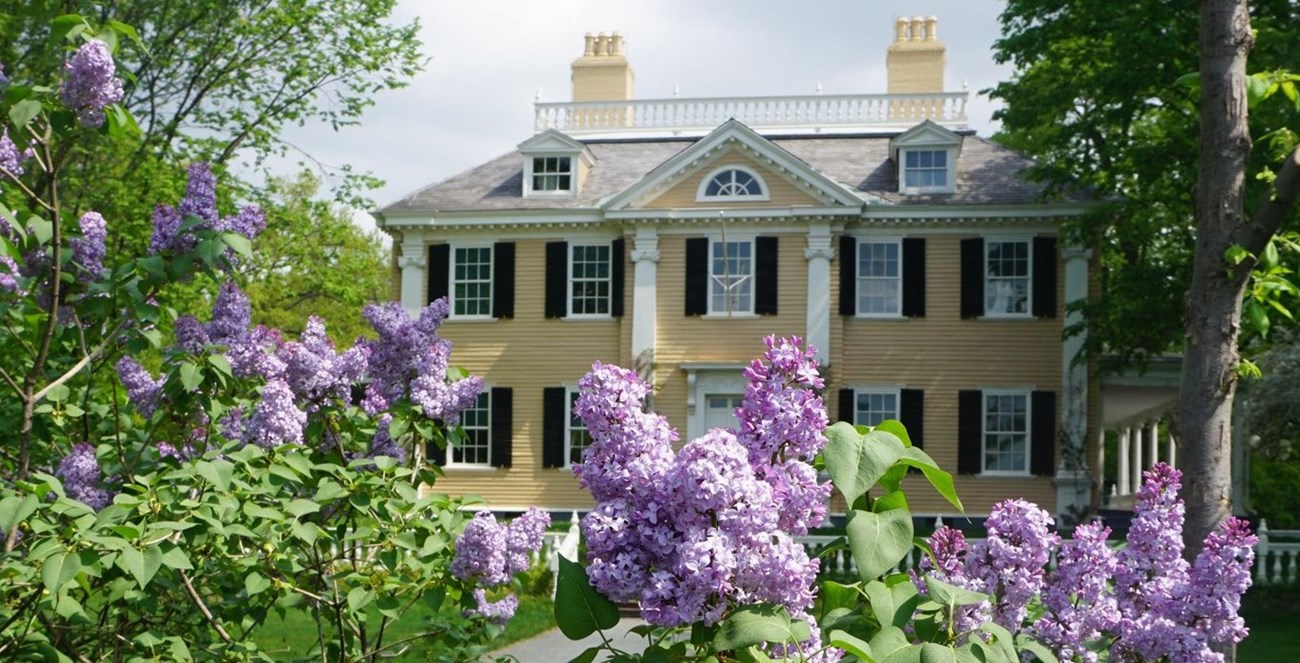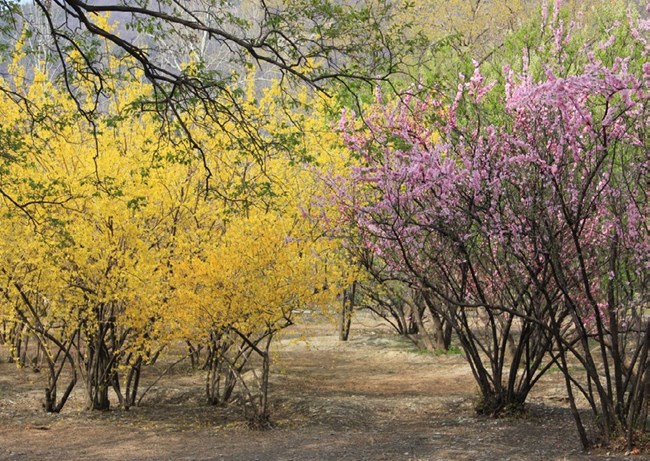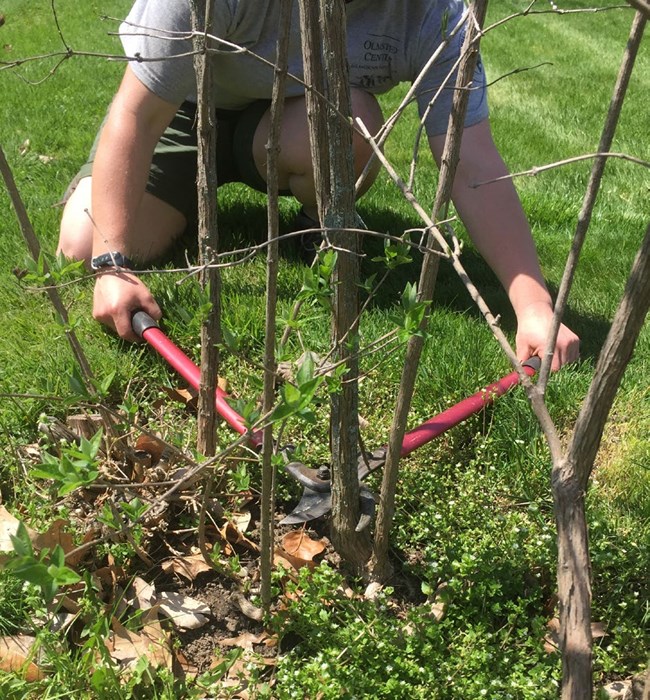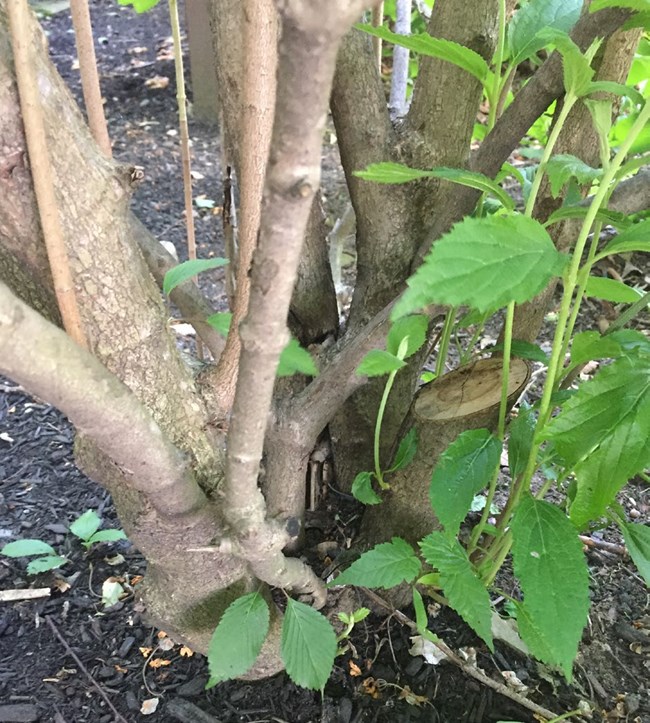Part of a series of articles titled Preservation Matters.
Article
Preservation Matters: Landscape Maintenance - Rejuvenating Historic Deciduous Shrubs

Longfellow House-Washington's Headquarters National Historical Site
Shrubs can be important features of cultural landscapes when they are associated with, and contribute to, con-veying the significance and character of a historic prop-erty. Shrubs often stay alive in a landscape for decades, sometimes centuries. However, if shrubs are not carefully maintained, with age they can lose vigor, deteriorate, and die. Pruning of older shrubs can effectively rejuvenate and preserve them as contributing features of a cultural land-scape.
The photograph above shows how properly maintained de-ciduous shrubs can survive and thrive at historic sites. The lilacs pictured are located at the Longfellow House-Wash-ington’s Headquarters National Historic Site in Cambridge, Massachusetts, and remain from the historic period of when Henry Wadsworth Longfellow, one of the world’s foremost 19th century poets, lived and worked at this site from 1837 until his death in 1882.

IMPORTANCE OF CULTURAL LANDSCAPES
Cultural landscapes can be historically significant for their association with a person or event import-ant to our nation’s history; if designed by a master landscape architect, horticulturist or gardener; or because they can provide information about our nation’s history or prehistory. Shrubs that are original elements of such landscapes may convey or express the site’s history and contribute to its significance through:
- direct association with important people who may have planted them;
- surviving through or “witnessing” historic events;
- being specifically cultivated or planted as a special visual or functional feature in the landscape;
- having unique growth qualities or characteristics; and
- no longer being available through the horticulture nursery trade.
Such shrubs should typically be cared for and preserved as original fabric of a cultural landscape, like the original architectural woodwork of a historic structure or furnishings found in a historic home.
HOW SHRUBS GROW AND AGE
A multi-stemmed shrub is a branched woody plant that is usually less than fifteen feet in height and more than two or three stems, none of which are a main or dominant stem, originating from or very near the ground. Shown here are forsythia and redbud, two multi-stemmed deciduous shrubs that demonstrate typical growth habit (Source: https://pxhere.com/en/photo/740459).
Branches of shrubs and hedges generally grow from three areas of the plant:
- buds at the end of each stem that develop shrub height and width;
- buds that are just below the bark along the mid-dle of woody stems that develop density of shrub branches; and
- buds that emerge from the base of the plant at the ground level that grow to replace older or deteriorated stems.
As shrubs age, individual stems and branches, particularly the oldest, have less ability to photosynthe-size, sustain foliage and flowers, deter insect and disease impacts, and physically support their own weight. As a result, the oldest stems begin to deteriorate and die, resulting in poor plant form and potential loss of the entire shrub.

CPepper 2018
REJUVENATING MULTI-STEMMED SHRUBS
Applying knowledge of how multi-stemmed shrubs grow, pruning techniques can rejuvenate deteriorating shrubs into vital, healthy speci-mens. This process of maintenance pruning will ensure that historic shrubs are preserved in the cultural landscape.
Pruning of mature multi-stemmed shrubs:
- Identify the oldest stems emerging from the base at soil level. These stems typically have the widest diameter and often have fur-rows and/or ridges as compared to younger stems.
- Using loppers or a pruning saw, cut the older shrub stems at an approximately 45-degree angle about 4-6 inches from the soil level.
- Completely remove the cut stem and all attached branches from the shrub.
- Repeat the removal of individual stems until 1/4 to 1/3 of all of the stems have been removed. Do not remove more than 1/3 of all shrub stems in any year.
- New stems will emerge from the base of the plant at ground level to replace those re-moved by pruning.
- Repeat this rejuvenating pruning process ev-ery 3 to 5 years to regularly encourage new stems to grow in place of old deteriorating stems.

CPepper May 2018
This Preservation Matters focuses on multi-stemmed deciduous shrubs. While some of the information provided will apply to ever-green shrubs, there are differences. Please check a horticultural reference before apply-ing the pruning techniques above to mature evergreen shrubs.
A CLOSER LOOK
The lilacs depicted on the top of the page are over 175 years old. In a journal entry from April 18, 1844, Longfellow mentions the planting of a lilac hedge along the fence in front of the house. In May 1861, he wrote in his journal “The purple buds of the lilac tip the hedges: and the flowering tide of spring sweeps on” (Henry Wadsworth Longfellow, Journals, Houghton Library).
REFERENCES
National Park Service. Treatment of Plant Features. Landscape Line 12. Available online at https://irma.nps.gov/DataStore/DownloadFile/515105 (accessed on 26 May 2020)
Rakow, Donald A., and Richard Weir, III. Pruning: An Illustrated Guide to Pruning Ornamental Trees and Shrubs, Cornell Uni-versity Cooperative Extension, Information Bulletin 13. Available online at https://s3.amazonaws.com/assets.cce.cornell.edu/attachments/18613/pruning-an-illustrat-ed-guide-pruning-ornamental-trees-shrubs. pdf?1479319199 (accessed on 26 May 2020)
ABOUT NCPTT
The National Center for Preservation Tecnology and Training (NCPTT) is the principal research, technology and training center within the National Park Service.
NCPTT helps preservationists find better tools, better materials, and better approaches to conserving historic buildings and landscapes, archaeological sites, and museum collections. It conducts research and testing in its labora-tories, provides cutting edge training around the U.S., and supports research and training projects at universities and nonprofits. NCPTT pushes the envelope of current preservation practice by exploring advances in science and technology in other fields and applying them to issues in cultural resource management.
NCPTT publishes its Preservation Matters Series to provide easily accessible guidelines for preserving cultural materials.
National Center for Preservation Technology and Training
645 University Parkway
Natchitoches, LA 71457
Website: www.nps.gov/ncptt
Phone: (318) 356-7444
Credits
- Author: Charlie Pepper, Principal, Landscape Preservation Specialists
- Series Editor: Kirk A. Cordell, NCPTT Executive Director
Last updated: September 29, 2022
